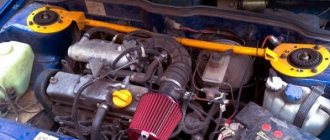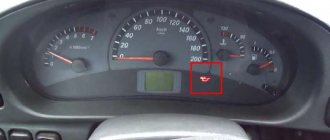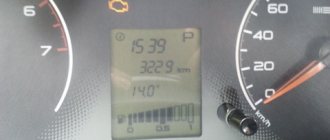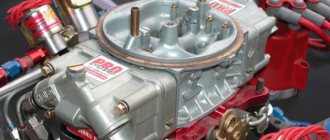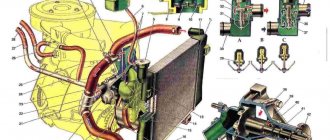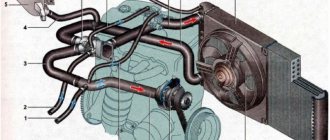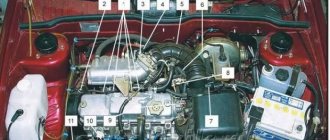Have a nice day everyone, today I will explain why high idle speeds occur, what is the reason, and how the problem is solved. I’ll say right away that this is a sign of a malfunction that should not be ignored, if only because of increased gas mileage, which is not beneficial to anyone. Plus, unnecessary high speeds mean a reduction in engine life when major repairs are approaching at warp speed. High engine speeds can appear in both carburetor and injection cars.
High engine speed at idle
The main task of the idle speed system (mode) is to maintain engine speed at a minimum level, ensuring complete combustion of the fuel-air mixture in the cylinders. The number of idle speeds on different engines may vary, the range is 700-950 rpm. Excessively low tachometer readings lead to unstable engine operation, which may stall. On the other hand, high engine speeds at idle are fraught with excessive fuel consumption and more toxic exhaust. Below we discuss the main reasons for the increased and unstable crankshaft speed at idle for a carburetor and injection engine.
- Carburetor internal combustion engines
- Ignition system
- Injector
- Idle air control sensor (IAC)
- TPDZ
- How to remove and install a new sensor
- Throttle valve
- Engine temperature sensor
- Mass air flow sensor (MAF)
- Intake manifold
- Electronic engine control unit
- Generator
- Crankcase ventilation (PCV) system
- Turbocharger
- Results
Diagnosing the injection system in the garage
The main factor in this process will be your luck, because when buying a car, motorists are very rarely interested in the brand of the ECU. Two types of brains were installed in the VAZ 2114, and the dashboards for the car were produced by Schetmash and the German VDO.
If you have the first option, you are out of luck; you will have to contact a car service and contact a qualified specialist, but the owners of the second option are much more fortunate, because it is equipped with a self-diagnosis system.
VDO control panel
Diagnostics via the VDO panel is performed as follows:
- Turn off the ignition and press and hold the odometer button.
- Then turn on the ignition and release the button.
- First, arrows will appear on the screen, after which you will need to press 2 more times, after the first, information about the firmware will be displayed, and after the second, the error code itself.
- To end the panel operation by resetting the error, you can hold the button pressed until the countdown ends and 0 appears on the screen.
The interpretation of the errors is as follows:
- 42 – problems with ignition;
- 14.15 – problems with the coolant sensor;
- 1 – indicates that the ECU itself is faulty.
- 22, 23 – TPS requires replacement;
- 44.45 – lean / rich fuel mixture, respectively;
- 33.34 – mass air flow sensor is faulty;
> Useful video
You can find more interesting information on this issue in the video below:
Idle mode
Idle speed is the operating mode of a car engine with the gear in neutral. It is characterized by minimal engine load and low fuel consumption.
Idle mode is used:
- for delivering motor oil from the engine crankcase to friction units after a long period of parking the vehicle;
- to warm up the power unit in the cold season;
- in cases where turning off the motor is impossible or undesirable.
During normal engine operation, the crankshaft speed is idling at 2000 rpm. gradually decrease to 800, then maintaining at this level. However, it also happens that the power plant, when switching to this mode, operates unstably - it randomly changes the speed in the range of 500–1500 rpm, “chokes” and stalls. This tells us: a failure has occurred in the engine control system, the causes of which must be diagnosed and eliminated as soon as possible.
The movement of the arrow of the device shows the change in the number of engine revolutions
Determining the specific cause of the malfunction is not easy, but it cannot be ignored - this can lead to critical engine failure and the need for expensive repair work. In addition, driving a car with an engine that is unstable at idle speed distracts the driver's attention. He has to constantly monitor changes in the speed and keep his foot on the gas pedal, preventing the engine from stalling when braking or stopping briefly.
Carburetor internal combustion engines
Here the vast majority of reasons lie in the dosing device itself. The high idle speed in this case is due to:
- Incorrect minimum setting. The mixture supplied with the carburetor must be adjusted using the appropriate screws.
- Stuck choke: If it doesn't open all the way, not enough air is getting into the cylinders.
- First camera shutter. It may not close completely due to a mechanical defect or an incorrectly adjusted actuator.
- The fuel level in the carburetor float chamber is too high
Ignition system
The reason for the speed fluctuation may be a damaged distributor cap, high-voltage wires or spark plugs. These elements should be checked and replaced if necessary.
It is also worth noting very common reasons inherent in both types of engines: incorrect adjustment of the transmission accelerator pedal and its jamming, associated with corrosion of the spring support shaft due to prolonged inactivity of the vehicle.
Source
Idle mode
Idle speed is the operating mode of a car engine with the gear in neutral. It is characterized by minimal engine load and low fuel consumption.
Idle mode is used:
- for delivering motor oil from the engine crankcase to friction units after a long period of parking the vehicle;
- to warm up the power unit in the cold season;
- in cases where turning off the motor is impossible or undesirable.
During normal engine operation, the crankshaft speed is idling at 2000 rpm. gradually decrease to 800, then maintaining at this level. However, it also happens that the power plant, when switching to this mode, operates unstably - it randomly changes the speed in the range of 500–1500 rpm, “chokes” and stalls. This tells us: a failure has occurred in the engine control system, the causes of which must be diagnosed and eliminated as soon as possible.
The movement of the instrument needle shows a change in the number of engine revolutions. Determining the specific cause that caused the malfunction is not easy, but it cannot be ignored - this can lead to critical engine failure and the need for expensive repair work. In addition, driving a car with an engine that is unstable at idle speed distracts the driver's attention. He has to constantly monitor changes in the speed and keep his foot on the gas pedal, preventing the engine from stalling when braking or stopping briefly.
Advertisements on NN.RU - Auto
Manufacturing of a broken-type platform with retractable ramps on the GAZ-33023 Gazelle-farmer chassis. Technical characteristics of the tow truck.
With us you can not only extend the frame to fit a body of 5.1 m, 6.2 m, 7.5 m, 9 m for Maz Zubrenok, Maz, Kamaz, Ural, Zil, Mitsubishi, Nissan.
The broken-type towing platform produced in our company has a highly reliable design, which is confirmed by many years of use.
Conversion of a cargo-passenger gazelle, an all-metal gazelle, an autoline into a cargo gasel 3302 gas 33023 gazelle-farmer includes c.
Imagine, you wake up in the morning, open the curtains, bright sunlight bursts into your apartment, and outside the window is a stunningly beautiful landscape.
Russian singer and composer Willy Tokarev died at the age of 84. His son told RIA Novosti about this.
Young parents living in the Tsvety residential complex can be congratulated - by September they will have a brand new kindergarten for 320.
How to measure generator voltage?
In order to notice changes in the readings on your car’s generator in time, you need to learn how to measure them.
There are two ways. The first one is quite easy, but not very accurate. You can view the voltage readings on the on-board computer. However, they cannot be called reliable, since they are often underestimated. Or the voltage may jump from the load. And this does not always mean a malfunction. The reason may be that some consumer is too powerful or is not connected as needed. Or maybe it’s all about the error of the device.
The second method requires more time and effort, but it allows you to determine the data more accurately. To perform this you will need a multimeter and an assistant.
You need to do the following:
- Turn on the ignition and wait until all warning lights on the instrument panel light up normally.
- Start the car and make sure the battery light goes out. If not, then you need to look for a breakdown - the generator or battery may be faulty, or there may be problems with the wiring.
- The car must warm up to operating temperature, and all existing electrical consumers must be turned on.
- The multimeter is set to voltmeter mode.
- An assistant is involved in the work: he must maintain the engine speed within 3500.
- Connect the multimeter to the battery.
- Take measurements. Normally, a reading of 13-13.2 V or a little more should appear on the multimeter. If the number is lower, this is a sign of a faulty generator or battery.
The same sequence of actions should be carried out with switched off consumers. If the generator is working properly, the multimeter will show approximately 14.5-14.7 V.
When connecting a multimeter to the generator terminals, the readings should be within 14-14.3 V. When the assistant increases the engine speed, the voltage should change by no more than 0.5 V. If its value fluctuates greatly, this is a sign of a malfunction in the device.
Lada 2115 2004, engine Gasoline 1.5 liter., 80 hp, Front drive, Manual - DIY
My XX speed was 820 - 840 (I think), I went and flashed the firmware from Paulus, and asked to raise the idle, so he raised it and I sat in the cabin and listened, as soon as it became normal, don’t shake anything - I said enough (the master said that more and it’s not worth it), now the rpm is 940. In my opinion, something is wrong and by raising the rpm I eliminated the symptom, but the problem exists, but I spent so much money on diagnosticians and replacing all the sensors (DPS - 3 pcs., DXH - 3 pcs., MZ, mass air flow sensor, spark plugs, wires, injectors, valve adjustment - 2 times, flashed three times) and all this in two months, all possible diagnostics where they unanimously told me everything was great, even better than on the new one. And I’m thinking, if I went straight to this master, I would only spend 1,500 rubles. and was happy. Here.
Yesterday there were no misfires, the engine worked perfectly, and even the first frosts hit, so far I can start it at -20 without any problems))))
I have the same garbage, but there are no gaps, I don’t bother, a diagnostician I know said that it won’t worry, half a day 850 900, half a day 700 800 rpm
Okay, thanks for the advice! How much does the firmware cost approximately? And now I found a thread, I think I’ll also try to sharpen the damper this weekend www.drive2.ru/cars/lada/2…/288230376152332915/#post
Flushing the throttle did not help me, the same garbage remained. We flashed the “brains” - OXX became 900 rpm. There's a lot of beauty in the cabin))) And if you decide to “stitch”, then at the same time you’ll do diagnostics - you’ll find out what’s wrong with the 4th cylinder. The main thing here is to choose a normal master...
What kind of firmware did you do? Otherwise I have similar garbage.
I'll try it, thanks.
Regarding the speed, try cleaning the throttle valve.
VAZ 2114 has low idle speed
What needs to be done to adjust the operation of such an important part of the car?
- The first thing to do is turn off the battery. Some drivers believe that it is enough to turn off the ignition, but in reality this is not the case. You need to turn off the so-called “mass”.
- When this is done, you need to proceed to unscrew the fasteners holding the regulator. In this way you can completely remove it. This will not be difficult if you do everything carefully and without haste. Some models have one unpleasant feature. The fact is that their screws are filled with special paint. Sometimes they are completely drilled out. In this case, you will have to completely dismantle the damper body. Once this is done, you can disassemble the regulator and remove it.
- Now it’s the turn to clean the landing channel. You can simply rinse it and then treat it with a powerful air stream. A gas can or a simple compressor is suitable for this. The regulator should be disassembled very carefully, otherwise any unpleasant consequences are possible. For example, you can easily damage the winding. After this you need to start checking the bushing. If something is wrong, then it is better to replace it with a new one.
- The next step is to determine the integrity that characterizes the spring. To do this, you can use a special measuring device. It will not be superfluous to clean the winding contacts. Only after this can you start assembling the idle air control, but at the very beginning you need to measure the distance from the conical needle to the flange. It should be 23 mm. If the distance is different, then you need to change the needle.
- The last step is to install the regulator in the place where it was before it was removed from the car. It has its own seat. That's where he needs to be returned. This must be done as carefully as possible. Once the regulator is in place, you need to connect the plug to it. You can do this yourself.
Now it's time to turn on the power. The engine should be started. If you still cannot fix the problems, you will have to disassemble the regulator a second time. If the next attempt is unsuccessful, the driver should be advised to reflash the on-board computer.
This may be relevant for those who purchased a car on the secondary market, but reflashing is a last resort. Usually all car owners just need to disassemble the regulator and repair it.
- Purpose, symptoms of malfunction, replacement and repair of the idle speed sensor (regulator) (IAC) VAZ 2114
- Engine from Priora to VAZ 2114: real or not
- We find out why the oil pressure light on the VAZ 2114 is on
Sergey please tell me this is a problem I start the engine of a VAZ 2114 8 valve car the speed rises to two thousand then gradually drops to 1000 and 800 what can be done thanks for your understanding
Sergey, hello, where can I find out the numbers of the sensors corresponding to the ECU or engine, VAZ 2114 16 valves 1.6, there is a problem with xx speed.
Women's reasons
This conditional category includes reasons that sometimes arise from people who are inattentive or late in servicing their car.
These include:
- This category also includes the purchase of fuel at the gas station “on the left” - the purchase of cheap “brands” with various additives, disguised under the names “E”, “EP” and others. It is not profitable for large supply chains to deceive customers, because selling regular fuel is cheaper than paying bribes to everyone, especially when it comes to the scale of the country, but the legislator does not prohibit the sale of about 95Er, while the alcohol content is honestly indicated in the technical specifications. All drivers know this, but greed takes over and this fuel eventually kills the engine. The same situation has developed around “cheap underground” gas stations that sell fuel spilled by truck drivers or military personnel.
- Dirty fuel and air filters - a sign of this problem is when the VAZ 2114 freezes while moving or when you press the fuel pedal. Both filters are involved in the formation of the fuel mixture, so if there is a fuel breakdown, gasoline is supplied unstably, and if there is air, the mixture becomes excessively enriched, which in both cases leads to flooding of the spark plugs.
- Spark plugs - this car part can fail not only for the reasons listed above, but also due to durability and improper care. Experienced motorists check spark plugs in VAZ cars at least once a month. To do this, you need to unscrew it with a spark plug wrench and evaluate the carbon deposits: a working spark plug has a light gray electrode and light brown carbon deposits. If the color is different, it's time to buy a new set.
- Lack of fuel - everyone knows that it is better to drive with a full tank, but domestic motorists, due to constant lack of money, the eternal crisis in the country and other similar reasons, prefer to drive with an almost empty tank and only refuel when absolutely necessary. At the same time, the accuracy of FLS on domestic cars is far from ideal, and VAZ is no exception. Therefore, stopping at an angle, driving until the car stops, filling the tank along the way from the tank has a very negative effect on the fuel system, debris gets into it, and the fuel is constantly replenished with air.
- Evil Gas Stations: When it comes to cars, the saying “the miser pays twice” is more apt. Garage services, repairs from friends and other attempts to save money often end with the fact that your VAZ 2114 does not have a non-working injector, there are problems with the engine and repairs need to be done at an official service center.
Overspeed tachometer
Repair rules
The idle speed regulator is a special executive function that is necessary for the engine to operate in normal mode. If it turns out to be faulty, the indicator that indicates this fault will not light up. This means that identifying the problem can be quite simple. All that remains is to eliminate it as soon as possible.
The regulator is a stepper motor that makes it possible to guarantee a certain level of air flow that bypasses the closed damper.
The flow level is set by the car's electronics. Such a complex system allows the motor to operate as evenly and stably as possible. Also, the electronic system of the machine performs the function of protecting against external factors, because the engine operates normally under almost any circumstances.
Answers:
— there may be several reasons: spark plugs, wires, dirty injectors, dirty throttle, unadjusted valves, and if the engine is 1.6, then it seems like vibrations in the cabin are normal, of course in moderation, but perhaps the engine mounts are tired
— A comprehensive answer. Indeed, injectors can behave inappropriately when cold.
— I haven’t cleaned anything, I haven’t replaced anything, I haven’t eliminated the floating of revolutions in 3 years, I only eliminated the tripping when cold, it turns out that because of the valves, these cars are a pit with congenital faults, sometimes it’s not worth going deeper
— They wrote correctly about the forces. While the engine is cold, it works without lambda, and there are no corrections. As soon as the ECU gave the command to work in the reverse loop, everything is compensated and it works. You need to contact an adequate diagnostician for 10 minutes. Based on the magnitude of the correction, everything will become clear
— I recently installed the valves and also changed the high-voltage wires, the injectors will need to be cleaned, but could such a problem arise due to the PD sensor? Yes, I also cleaned the 1.6 engine 8 valve throttle
- Damn, was my post ignored? If you want a headache and money down the drain, change everything. I calculate the trouble for 10-15 minutes of communication with the car, what’s so complicated about it?
— Hello everyone, I also have the same problem with the xx engine, it floats from 500-900 and is afraid, I changed the throttle sensor and xx stroke, changed the filter and spark plugs, cleaned the throttle valve, no changes have happened yet, sometimes it won’t start the first time, that is, it will start on for a second and stalls. Sometimes the BC check lights up and issues DK1. Could this be because of it?
- It’s such a disaster, it troits chaotically, regardless of whether it’s cold or heated. Spark plugs, wires, valves replaced everything, ran for about 2 thousand and then it started......What to do?
— there was a similar situation, 3 diagnosticians did not find anything, they reset the errors, the car worked perfectly after 20 minutes, again tripping and floating rpm, then I came across a normal diagnostician, the reason was in the firmware. I rebooted and everything is fine
- Well, we need a really normal-thinking diagnostician, and not an ERROR-READING ERASER, and it will make sense.
Based on materials from the Lada Forum: lada-forum.ru
Troubleshooting
It is not difficult to understand that the problem is in the sensor; for this you do not need to go for expensive diagnostics. There are visible indicators that help determine this breakdown:
- The idle speed of the VAZ 2114 floats. This is especially noticeable if you additionally turn on some devices, such as a stove, car radio, light;
- When switching to neutral speed, the engine stalls;
- The motor is tripping;
- Body vibration is also possible. All together, these are already signs of a malfunction of the idle speed sensor. Also an indicator is the lighting of the “Check engine” icon, but in this case it may not always light up.
There are several solutions to this problem:
- clean it;
- replace the failed spare part with a new one.
But before we decide what will be necessary in this particular case, we first find out whether it can be repaired. In any case, for accurate diagnosis, the regulator must be removed. Below is a picture that, to simplify the search, will show what the idle speed sensor looks like.
Replacing the IAC on a VAZ 2114
We have decided on the appearance, but in order to remove it, we need to decide where the idle speed sensor is located. We focus on the gas pedal, to which the cable goes. We look for the idle speed regulator on the VAZ 2114 opposite this cable, namely on the throttle valve, which is located below its position sensor. It is glued or attached with just two bolts.
To remove it you need:
- Be sure to turn off the car’s ignition and remove the battery terminals;
- Pull out the connector by disconnecting the wires leading to it;
- Unscrew the wires with a suitable screwdriver and remove the spare part itself;
- If the sensor is glued, you will first have to pull out the throttle assembly completely, and then carefully peel off the sensor.
Troubleshooting
To more accurately determine the problem, it is recommended to first carry out a full diagnosis. If you don't have the time or money to take your car to a gas station, we recommend using a personal ODBII scanner. In our case, this will be the Korean-made Scan Tool Pro Black Edition model
.
This scanner operates on a 32-bit chip (analogues in the budget segment have an 8-bit controller) and is assembled only from high-quality components, thanks to which it is capable of diagnosing not only the engine, but also other components of the car.
In most cases, the root cause of overspeeding is a dirty air filter, faulty throttle position sensor, idle speed sensor or mass air flow sensor. In addition to detecting errors for more detailed diagnostics, Scan Tool Pro can monitor the status of all available sensors in real time, helping you quickly determine the exact cause of the problem.
Air filter
The first thing you need to check, noticing the high idle speed of the VAZ 2114, is the air filter. When it becomes dirty, it begins to pass air poorly, as a result of which the working mixture entering the engine becomes excessively rich and causes an increase in speed. To fix this problem, just replace the filter with a new one.
Air filter VAZ 2114
Since the performance of the engine directly depends on the condition of the air filter, it is advisable to periodically check its condition without waiting for severe clogging.
Throttle position sensor
If this does not help, you should move on to checking the sensors, that is, the throttle position sensor, since most of the time it fails. To do this, it is necessary to measure the voltage at its contacts to a minimum (the voltage value should be close to zero).
Throttle position sensor VAZ-2114
If it turns out that voltage close to normal in the on-board network constantly passes through the sensor, acidification has occurred and cleaning should be carried out.
For this you will need:
- Disconnect the wires from the sensor terminals.
- Remove the pair of mounting screws that hold the case in place.
- Fill the cavity with VD-40 or similar penetrating lubricant.
- Turn the sensor wheel with a screwdriver or thin blade.
- I put the device back.
Idle speed sensor
If the cause was the gas sensor, the idle speed should immediately return to normal. If this does not happen, you should start cleaning the idle speed sensor (as it often oxidizes and fails).
Minimum sensor VAZ 2114
This is done as follows:
- Disconnect the wiring and disassemble the device by unscrewing the mounting screws (the sensor itself is located near the throttle valve, opposite its cable).
- Connect the cables to the device and turn on the ignition. If the moving needle of the sensor is slightly pressed into the body, it means it is working normally, otherwise the sensor is acidic and needs cleaning.
- Clean the entire surface of the sensor with WD-40 or refined gasoline, removing all traces of oxides, oil and other contaminants.
- Reinstall the sensor, start the engine and check its operation.
The most convenient tool for cleaning an inactive sensor is a small toothbrush - it allows you to completely clean the device without damaging it.
If after cleaning it is found that the speed is still too high and the sensor does not work normally, it must be replaced with a new one of the same model.
Mass air flow sensor
If all the previous operations did not help and the increase in idle speed of the VAZ 2114 remains, it is necessary to check the mass air flow sensor.
this is quite simple to do: you just need to disconnect the wires going to it, then start the car and drive a certain distance with a crankshaft speed of more than 2000 per minute. If at the same time it “feels” like the car has begun to behave more dynamically than with the connected sensor, the cause of the malfunction will become more than obvious.
DMRV VAZ 2114
To eliminate it, it will be necessary to disassemble the sensor and replace it with a new one, since, unlike previous sensors, it is practically irreparable.
It is replaced as follows:
- Disconnect the corresponding cables from the contacts of the air flow sensor.
- Loosen the clamp on the inlet pipe.
- Remove the handset from the handset.
- Remove the damaged sensor.
- Install the new device by performing all steps in reverse order.
To check the effectiveness of the repair, just start the engine and observe the idle speed - if they return to normal, the problem is solved.
Sensors, their purposes and malfunctions
Let's now talk in more detail about each of the sensors, let's look at where they are and what they look like.
Idle speed (IAC)
The device is located in the throttle assembly. It is a small induction coil with a needle inside. Depending on the controller readings, one or another voltage is applied to the coil winding and the needle extends a certain distance into the throttle pipe, regulating the air supply. With this, the idle speed is adjusted.
Idle speed control
There is no indicator responsible for this sensor. Therefore, if this node fails, then this can be understood by the following “symptoms”:
- The engine stalls at idle or when changing speed;
- “Floating”, unstable idle speed;
- When turning on a cold engine, there is no increased speed.
To replace the sensor, you must turn off the power to the machine's wiring, completely disconnect the throttle assembly, and then remove the sensor from it, after first disconnecting the terminals that supply electricity to it. In place of the old sensor, you need to install a new device and place the throttle assembly in place.
Detonation (DD)
The knock sensor is located between the cylinders on a car engine and reacts when the fuel detonates inside the cylinder. In essence, it is a piezoelectric element. When gasoline detonates, the sensor converts the resulting vibrations into electricity. Current is supplied to the on-board computer and signals a fuel explosion. After this, the ignition timing is automatically adjusted.
If this type of sensor breaks down, the fuel begins to detonate in the engine. To check the device for functionality, you need to disconnect it using a key from its mounting location, connect it to a voltmeter and knock on it. If voltage was applied to the voltmeter, then the unit is working; if not, it is faulty.
To replace a device, you need to unscrew it from the seat using a key, disconnect the terminals from it and install a new device.
Oxygen (Lambda probe)
The oxygen sensor, also known as a lambda probe, is installed on the exhaust pipe close to the cylinders. It measures the amount of oxygen contained in exhaust gases and the environment. It only works when the engine is on, as it must be heated to function. When oxygen molecules hit the sensor, electricity is generated, which is supplied to the control unit. The on-board computer, based on sensor readings, regulates the supply of oxygen to the engine cylinders.
If the sensor fails, the following consequences occur:
- Unstable gasoline consumption: sometimes more, sometimes less;
- “Walking” speed at idle;
- A sharp drop in power when accelerating.
In order to replace this sensor, you need to turn off the power to the car, disconnect the wires going to the device, unscrew it with a key, and then put a new one in its place.
Crankshaft position (CPCV)
This sensor regulates the ignition of the combustible mixture in the cylinders depending on the position of the crankshaft. This position is determined by reading electromagnetic pulses from the toothed pulley of the electric generator. The sensor itself is located in close proximity to it.
Crankshaft position sensor
Symptoms of device failure may include:
- Idle speed instability;
- “Floating” speed;
- Power drop;
- Problems when turning on the engine.
At home, the performance of the sensor can be tested using a multimeter in ohmmeter mode. The resistance at the device contacts should be from 500 to 700 Ohms. If it differs greatly from these values, the sensor is faulty.
To replace the sensor, you need to turn off the power to the car's wiring, disconnect the battery, disconnect the electrical contacts from the device, and then unscrew the mounting bolt, remove the sensor and install a new one.
Camshaft position (CPRV)
This sensor, called DPRV for short, reads data from the camshaft. This happens with the help of a special gear installed on the shaft, on which two teeth are missing. This sensor is needed to adjust the ignition angle by the car’s on-board computer.
Camshaft position sensor
If this device breaks down, idling becomes unstable and the engine's fuel consumption increases.
The sensor is located to the left of the engine, near the air filter. Before replacing it, you need to de-energize the vehicle's wiring. Then you need to unscrew the sensor fixing bolt, remove it, disconnect the contact terminal, and then install a new device.
Coolant temperature (CLT)
The coolant temperature sensor (abbreviated as DTOZH) is located between the cylinder head and the thermostat. It measures the coolant temperature and transmits the resulting readings to the on-board computer. Based on this information, the rotation speed of the cooling fan is automatically adjusted, as well as the intensity of the pump pumping up antifreeze.
Procedure
To work, we need a laptop and a diagnostic cable.
Laptop
A laptop or tablet computer running a desktop version of the Windows operating system, as well as special software that is designed specifically for your car brand. Of course, you can connect a desktop computer, but then be prepared to take it outside, directly to the hood of the car.
Diagnostic cable for connection to the ECU
You will also need to purchase a cable to connect the on-board computer to the laptop. As a rule, these cables are divided into several main types, which do not differ very much from each other. Just decide which version of the connector is used in the car. In the oldest models this is the first version, and in newer ones this is the second version of the connector. The port is shaped in such a way that you will not be able to connect it incorrectly.
As soon as the connection to the on-board computer is completed, in the program running on the laptop, you can view all the parameters of the vehicle’s operation, as well as any errors that arose during the process. Error codes can be found in the documentation accompanying the program or on the Internet.
If necessary, new firmware can be installed on the on-board computer. This is done using the capabilities of the same diagnostic program.
Interruptions in the operation of the internal combustion engine and electrical equipment: signs, solutions
If the engine runs intermittently and there is a feeling that the engine is about to stall, you need to pay attention to the tachometer. If at the moment of unstable operation the arrow twitches, then the cause of the malfunction should be sought in the electrical equipment
These are symptoms of short-term failures in the ignition system (no spark). If there is no tachometer, you can determine problems with the spark without it. The car jerks sharply when driving.
But it is not always possible to quickly detect the causes of a short-term loss of spark. Often, as noted above, these are bad contacts or the ignition coil. Another culprit is the capacitor and dirty contacts. If new contacts are installed and the motor runs unevenly, this means they are bad.

